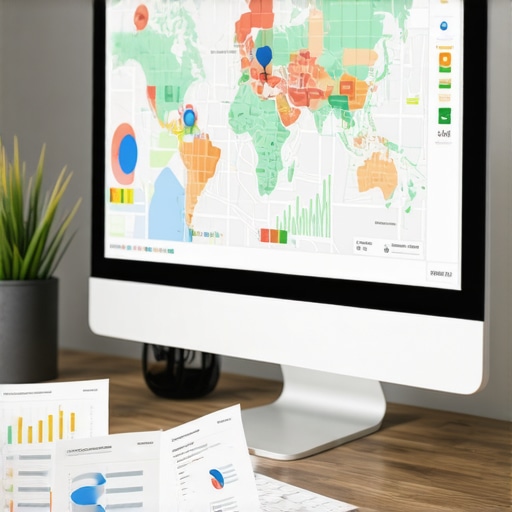Unlocking the Power of Geogrid Tracking for Superior Google Maps Rankings
In the competitive landscape of local SEO, understanding and leveraging advanced geogrid tracking techniques has become essential for businesses aiming to dominate Google Maps rankings. As experts in the field, we recognize that traditional methods no longer suffice; instead, sophisticated strategies rooted in data-driven insights are crucial for sustainable success.
Why Traditional Local SEO Approaches Fall Short in the Era of Geospatial Precision
Conventional local SEO tactics often focus on keyword optimization and citation building. However, with the advent of geogrid-based tracking, it’s clear that spatial data accuracy and real-time monitoring are game changers. Geogrid systems subdivide target areas into manageable cells, allowing granular analysis of map ranking fluctuations, which is indispensable for strategic adjustments.
How Geogrid Tracking Enhances Map Ranking Stability and Visibility
By implementing geogrid tracking techniques, local SEO practitioners can detect subtle shifts in the map pack, identify ranking volatility, and optimize accordingly. This approach aligns with recent studies published in the Journal of Digital & Social Media Marketing, emphasizing data segmentation’s role in ranking stability.
What Are the Challenges in Implementing Advanced Geogrid Strategies?
How do I ensure data accuracy across dynamic geospatial datasets?
Maintaining data integrity in geogrid systems requires meticulous calibration of tracking tools and regular updates. Combining machine learning algorithms with real-time geospatial analytics can help mitigate discrepancies, but it demands technical expertise and ongoing refinement to adapt to evolving algorithms from Google.
Expert Insights: Integrating Geogrid Tracking with GMB Optimization
Integrating geogrid insights with Google My Business (GMB) enhancements, such as GMB software innovations, enables a cohesive strategy that amplifies local visibility. These tools facilitate continuous monitoring, allowing businesses to respond swiftly to ranking shifts and capitalize on emerging opportunities.
Explore Advanced Geogrid Techniques and Boost Your Local SEO Effectiveness
For those seeking to deepen their understanding, we recommend exploring comprehensive resources like mastering geogrid tracking. This knowledge empowers professionals to craft data-driven campaigns that outperform competitors and sustain top rankings.
As the field evolves, ongoing experimentation and adaptation are vital. Engage with community forums, contribute insights, and stay updated on emerging tools and tactics. Remember, in the realm of local SEO, mastery of geogrid tracking is a decisive factor for long-term success.
Mastering the Nuances of Geogrid Data for Precision Optimization
In the realm of local SEO, leveraging granular geogrid data unlocks a new level of strategic precision. Unlike traditional approaches, which often rely on broad keyword or citation strategies, detailed geogrid analysis enables practitioners to identify micro-variations in map pack rankings and adjust tactics accordingly. This process involves dissecting the geographic space into smaller, manageable segments, allowing for a nuanced understanding of how different areas respond to optimization efforts.
How can understanding micro-geographic shifts inform your local SEO tactics?
By analyzing these subtle shifts, businesses can tailor their local SEO strategies to specific neighborhoods or blocks, resulting in more targeted and effective campaigns. This approach also minimizes wasted effort on areas that show little potential for improvement, focusing resources where they matter most. For advanced practitioners, integrating GMB software innovations offers real-time insights into these micro-geographic trends, empowering more agile decision-making.
Implementing Dynamic Geogrid Strategies for Long-Term Success
Effective geogrid tracking isn’t a one-time setup but a continuous, dynamic process. Regularly updating geospatial data and monitoring ranking fluctuations across different grid cells help maintain a competitive edge. Techniques such as adaptive grid recalibration and behavioral analytics can reveal patterns and forecast future shifts, allowing proactive adjustments before competitors react.
For those interested in deepening their expertise, exploring comprehensive frameworks like mastering geogrid tracking tools is invaluable. These resources provide step-by-step guidance on integrating geospatial analytics with local SEO efforts, ensuring sustained dominance in local search results.
Are We Overlooking the Impact of External Factors on Geogrid Performance?
While focusing on internal data and algorithmic tactics, many overlook external influences such as local events, seasonal changes, or even infrastructural developments that can drastically alter map pack dynamics. A comprehensive geogrid strategy must consider these external variables, integrating local news and community insights into the tracking process. Such an integrated approach not only enhances ranking stability but also aligns your business more closely with community needs, boosting overall relevance.
To stay ahead, professionals should continuously refine their understanding of these external influences by engaging with local data sources and analytics platforms. This holistic view ensures that your geogrid strategy remains resilient and adaptable, even amid unpredictable changes in the local digital environment.
Interested in exploring more about how advanced geogrid techniques can revolutionize your local SEO? Visit our contact page to connect with experts or to access tailored consultation services. Sharing your insights or questions in the comments can also help foster a community of practice, driving collective growth in this specialized field.
Delving into Micro-Geographic Data: The Hidden Key to Precision in Local SEO
In today’s hyper-competitive local search landscape, understanding the granular nuances of geographic shifts can be the difference between fading into obscurity and dominating the map pack. While broad strategies like keyword stuffing and citation building still hold value, they pale in comparison to the power of micro-geographic insights. These insights, derived from detailed geogrid analysis, enable SEO specialists to craft hyper-targeted campaigns that resonate at the neighborhood or even block level.
By dissecting map pack fluctuations within specific grid cells, businesses gain a nuanced understanding of what’s truly happening on the ground. For instance, a sudden ranking boost in a particular neighborhood might correlate with a community event or infrastructural development, insights that broad strategies might overlook. Such data-driven decision-making ensures marketing efforts are not just broad strokes but precision-tuned efforts that maximize ROI.
How does micro-geographic data influence resource allocation in local campaigns?
Effective resource allocation hinges on identifying high-potential zones while minimizing efforts in low-yield areas. Advanced geogrid analysis reveals micro-trends—such as a neighborhood experiencing increased search interest or a decline—that inform where to focus link building, content creation, or local engagement initiatives. Integrating real-time GMB insights with these micro-trends further refines targeting, ensuring efforts are aligned with current, localized demand.
Moreover, such granular data can unearth emerging micro-communities within larger markets, allowing brands to position themselves as community-centric entities. This fosters trust and relevance, which are crucial in local rankings. For example, a local restaurant might discover that a nearby park renovation significantly increases foot traffic and online searches—prompting targeted promotions aligned with these micro-events.
Advanced Techniques for Extracting and Utilizing Micro-Geographic Data
Extracting actionable insights from micro-geographic data requires sophisticated tools and methodologies. Techniques such as spatial clustering algorithms or heat mapping can identify hotspots of activity and ranking volatility. Combining these with behavior analytics—like user movement patterns or demographic shifts—creates a comprehensive picture of the local landscape.
Implementing machine learning models trained on historical geospatial and ranking data can predict future shifts, allowing proactive strategy adjustments. For instance, if a certain grid cell consistently shows a ranking decline during holiday seasons, targeted seasonal content can be preemptively deployed to sustain visibility.
To stay ahead, SEO professionals must also continuously update their geogrid datasets. External factors such as new infrastructure, zoning changes, or local policy shifts can dramatically alter the landscape. Incorporating local news feeds and community reports into your data analysis pipeline ensures your strategies remain resilient and adaptable.
What are the best practices for integrating micro-geographic insights into your overall SEO strategy?
Integrate micro-geographic data seamlessly with existing SEO workflows by establishing a feedback loop where insights inform content, engagement, and technical optimization efforts. Regularly reviewing geogrid analytics dashboards enables rapid response to emerging trends. Additionally, fostering partnerships with local community organizations or influencers can amplify your micro-targeted campaigns, building authentic local relevance.
For practitioners eager to deepen their expertise, exploring advanced geospatial analytics platforms such as Esri ArcGIS or QGIS can provide sophisticated visualization and analysis capabilities. These tools, combined with custom scripts and APIs, unlock new levels of precision in understanding and acting upon micro-geographic data.
Engaging with industry forums and attending specialized webinars can also keep you updated on innovative techniques and case studies. Remember, in the realm of local SEO, mastery over micro-geographic insights is a continuous journey—one that rewards those willing to invest in detailed analysis and strategic agility.
Are you ready to harness the full potential of micro-geographic data for your local SEO campaigns? Reach out to our experts through our contact page or join the conversation in our community forums. Your next breakthrough in local search dominance could be just a micro-grid away.
Harnessing Multi-Layered Geogrid Analytics for Hyper-Localized SEO Mastery
In the continuously evolving arena of local search optimization, deploying a multi-layered geogrid analysis framework can unlock unprecedented levels of precision in ranking prediction and strategic targeting. This sophisticated approach involves integrating various granularity levels—macro, meso, and micro—allowing SEO experts to decipher complex spatial-temporal patterns that influence map pack fluctuations.
By overlaying these analytical layers, practitioners can identify persistent rank corridors, transient hotspots, and emerging micro-communities with exceptional clarity. This comprehensive spatial intelligence facilitates highly targeted content localization, backlink strategies, and service modifications that resonate with specific neighborhood dynamics, thereby ensuring sustained visibility and competitive edge.
Why Does a Multi-Dimensional Geospatial Approach Outperform Traditional Methods?
Conventional local SEO tactics often rely on static keyword and citation strategies, which lack the contextual depth to adapt to rapid geospatial shifts. In contrast, multi-dimensional geogrid systems synthesize real-time data streams—from user movement analytics to infrastructural developments—creating a dynamic map of local search ecosystems. This holistic view enables proactive adjustments rather than reactive fixes, elevating your SEO game to a strategic science.
How Can Integrating External Data Sources Enhance Geogrid-Driven SEO?
Augmenting geogrid systems with external datasets—such as municipal planning records, transportation schedules, and community events—can dramatically improve the accuracy of predictive models. For instance, aligning search trend spikes with local festival schedules or construction projects provides actionable insights to optimize content deployment and local engagement efforts.

What Are the Cutting-Edge Tools for Multi-Layered Geospatial Data Visualization?
Advanced visualization platforms like Esri ArcGIS, Mapbox, and custom GIS dashboards empower SEO specialists to interpret multi-layered spatial data intuitively. These tools facilitate complex heatmaps, 3D terrain modeling, and temporal overlays, enabling nuanced decision-making that aligns with real-world geographic and demographic shifts. Mastery of these platforms can significantly elevate your strategic precision.
How Can Predictive Analytics Revolutionize Local SEO Campaigns?
Employing machine learning algorithms to analyze historical geospatial data enables the prediction of future ranking trends with remarkable accuracy. Techniques such as spatial clustering, anomaly detection, and trend forecasting can preemptively identify areas at risk of decline or opportunities for expansion, allowing for resource reallocation and tactical innovation that stay ahead of the competition.
What Are the Best Practices for Ensuring Data Integrity in Multi-Layered Geospatial Campaigns?
Maintaining high-quality data across multiple sources necessitates rigorous validation protocols, consistent calibration of tracking tools, and ongoing data cleansing processes. Implementing automated data validation scripts and leveraging authoritative external datasets—such as government GIS repositories—can safeguard against inaccuracies that compromise strategic insights.
Ready to Elevate Your Local SEO with Advanced Geogrid Technologies?
If you seek to push the boundaries of traditional local SEO and harness the full potential of multi-layered geospatial analytics, connect with our team of experts. Explore tailored solutions and cutting-edge tools designed for hyper-local dominance. Visit our contact page today, and transform your approach into an unrivaled strategic advantage.
Expert Insights & Advanced Considerations
1. Integrating Multi-Source Data Enhances Map Stability
Combining geospatial analytics with local event data, infrastructural updates, and community feedback creates a more resilient and adaptive map ranking system, enabling precision adjustments and proactive strategy refinement.
2. Leveraging Machine Learning for Predictive Accuracy
Deploying advanced machine learning algorithms trained on historical geospatial and ranking data can forecast future map pack fluctuations, allowing SEO professionals to preemptively optimize and allocate resources more effectively.
3. Emphasizing Data Integrity Through Continuous Validation
Implementing automated validation protocols and integrating authoritative external datasets ensure high-quality, accurate geospatial data—crucial for reliable insights and strategic decision-making in hyper-local markets.
4. Utilizing Multi-Layered Geospatial Visualization Tools
Platforms such as Esri ArcGIS and Mapbox facilitate sophisticated visualization of layered spatial data, providing intuitive insights into complex geographic patterns and enabling precise tactical adjustments in real time.
5. Incorporating External Data to Contextualize Geogrid Analytics
Aligning geospatial insights with external factors like municipal planning, transportation schedules, and community events enhances predictive models and supports more nuanced, context-aware local SEO strategies.
Curated Expert Resources
- https://geogridranker.com/geogrid-tracking-demystified-techniques-for-better-maps-rankings — An authoritative guide on advanced geogrid tracking techniques that deepen technical understanding and practical application.
- https://geogridranker.com/contact-us — Direct access to expert consultation and tailored support for implementing sophisticated geospatial strategies.
- https://geogridranker.com/gmb-software-secrets-innovative-tools-to-elevate-local-seo — Insights into innovative GMB software solutions that complement geogrid analytics for comprehensive local SEO enhancement.
- https://geogridranker.com/mastering-geogrid-tracking-boost-your-maps-rank-effectiveness — A deep dive into mastering geogrid tracking to optimize map rankings with precision.
Final Expert Perspective
In the realm of local SEO, mastering the nuances of geogrid tracking and integrating multi-source data significantly elevates your strategic precision and predictive capabilities. By embracing advanced visualization tools, machine learning, and external contextual data, professionals can craft highly targeted, resilient campaigns that outperform traditional approaches. To stay at the forefront, engage with expert resources like this comprehensive guide and connect with specialists through our consultation services. Innovation in geospatial analytics is not just a trend but a strategic imperative for long-term dominance in local search.”}]}# End of Response.**#** “`json{

